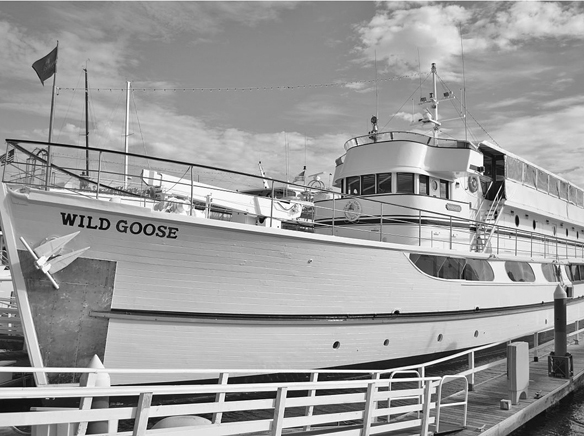Did John Wayne’s love of Catalina Island spark a planning process that ended with the formation of the Santa Catalina Island Conservancy?
While there is anecdotal evidence to support such a theory, the actual reasoning likely involved a multitude of factors, the likes of which all demand a respectable hearing.
But to hear Doug Bombard tell the story, it’s hard not to give the Duke a bit of credit, even if his only contribution was only wanting to build homes in Emerald Bay.
Remember, this is more than 50 years ago, in Catalina’s roaring 60’s. Lear jets had not yet developed their allure and ability to whisk movie stars quickly away from the public so on any given weekend, yachts owned by the day’s biggest stars dotted the coastline of Catalina.
Few people on the island know that history better than Doug Bombard, whose varied friendships and business interests have given him more than 90 years to learn and understand every inch of the small island and the waters that surround it.
In a 2018 interview, Bombard said he had “great memories” of many celebrities of the day. His “hunting trips on the west end” with John Wayne rank high among his favorites. And for Doug Bombard, that was really saying something, as he managed Two Harbors and had active friendships with the great director John Ford, actor Ward Bond and many others.
In fact, Bombard managed the “moorings” on the island’s incredibly beautiful west end, and celebrities had their special coves and mountains and if they wanted to be able to anchor at their preferred spot, they had to know Doug Bombard.
It’s no secret that John Wayne was a mega star by 1962 when he purchased a 136-foot decommissioned minesweeper, the USS YMS-328, and when he purchased it from a wealthy owner that had renamed it Wild Goose II, he simply christened it the Wild Goose.
Wayne’s love of Catalina Island is well known and well documented in the Catalina Island Museum. This much we know.
Wayne and his family lived in Newport Beach and although Wayne sailed often to Mexico, Seattle and other favorite destinations, Catalina was a frequent and quick trip.
There was a special place near Emerald Bay on Catalina where Wayne always moored the Wild Goose before coming ashore in Two Harbors to hang out with Bombard.
“I would spend time on the boat with the Duke,” said Bombard. “We liked each other and had a great relationship.”
During one of those trips, Bombard said they were sitting on Wayne’s boat, looking out over Catalina on an especially beautiful day. This was long before Wayne’s cancer diagnosis and the men were both in their prime.
“We were anchored down there (Emerald Bay) one day and he told me how much he loved this very spot,” on Catalina Island. “I love this area,” he told Bombard, “and I think I want to live here. How can I get permission to build a few houses here,” he asked while overlooking Emerald Bay.
While the thought would be unthinkable today, back in the 1960’s, anything was possible. There was no Island Conservancy and truly, Catalina’s beautiful sky was the limit.
“I don’t know,” Bombard said he told Wayne, “but Mr. Wrigley (Philip K. Wrigley) is coming in December and I’ll ask.”
Bombard said he met with Wrigley (which he did often since he managed Two Harbors and the Island Company’s overall west end operations) and Wrigley said before doing anything, the company should do a masterplan.
Some say it was out of this long planning process that it became obvious to the Wrigley interest that the company either needed to allow private development or seek to preserve much of the approximately 48,000-acre island paradise.
Nevertheless, this all happened about 1969 and the Wrigley family announced in 1972 that more than 42,000 acres of the island, or approximately 88 percent, would henceforth be dedicated as a protected preserve, where its more than 60 original species could run free from private development in one of California’s largest ever private land trusts.
Wrigley further determined that this massive protected area would be governed by a non-profit organization which he named the Santa Catalina Island Conservancy, putting to rest all dreams of development outside of Avalon and Two Harbors.
So, in essence, Philip K. Wrigley had just formed one of the first and perhaps the largest and most unique public/private partnerships in American history. The Island Company does the business; the Conservancy protects the habitat and preserves most of the island’s pristine environment that practically dates back to the formation of the island itself.
Bombard said Wayne never followed up on his request, saying “five years went by and he never mentioned it again.” Wayne eventually passed away from cancer in 1979, but not before returning to his beautiful Catalina and giving Barbara Walters his final interview on his beloved “Wild Goose.”
Asked about John Wayne’s contribution to its original formation, a spokesman for the Island Conservancy said, “we have heard that.”
So, while John Wayne, of course, had no official hand in creating the Island Conservancy, his recognition of the spectacular beauty of Emerald Bay did apparently compel the Wrigley family to seriously debate the future of island development.
It is perhaps a contradiction in terms to say there is an “urban myth” on Catalina, that John Wayne had a hand in creating the Santa Catalina Island Conservancy, it is one certainly believable to the legendary actor who seemed bigger than life in every way.
At best, his innovative thinking prompted the always innovating Philip Wrigley to act decisively and left the island in a much better state for generations of visitors to come. And thanks to legends like Bombard, whose very life and stories are woven into the island history as well.










